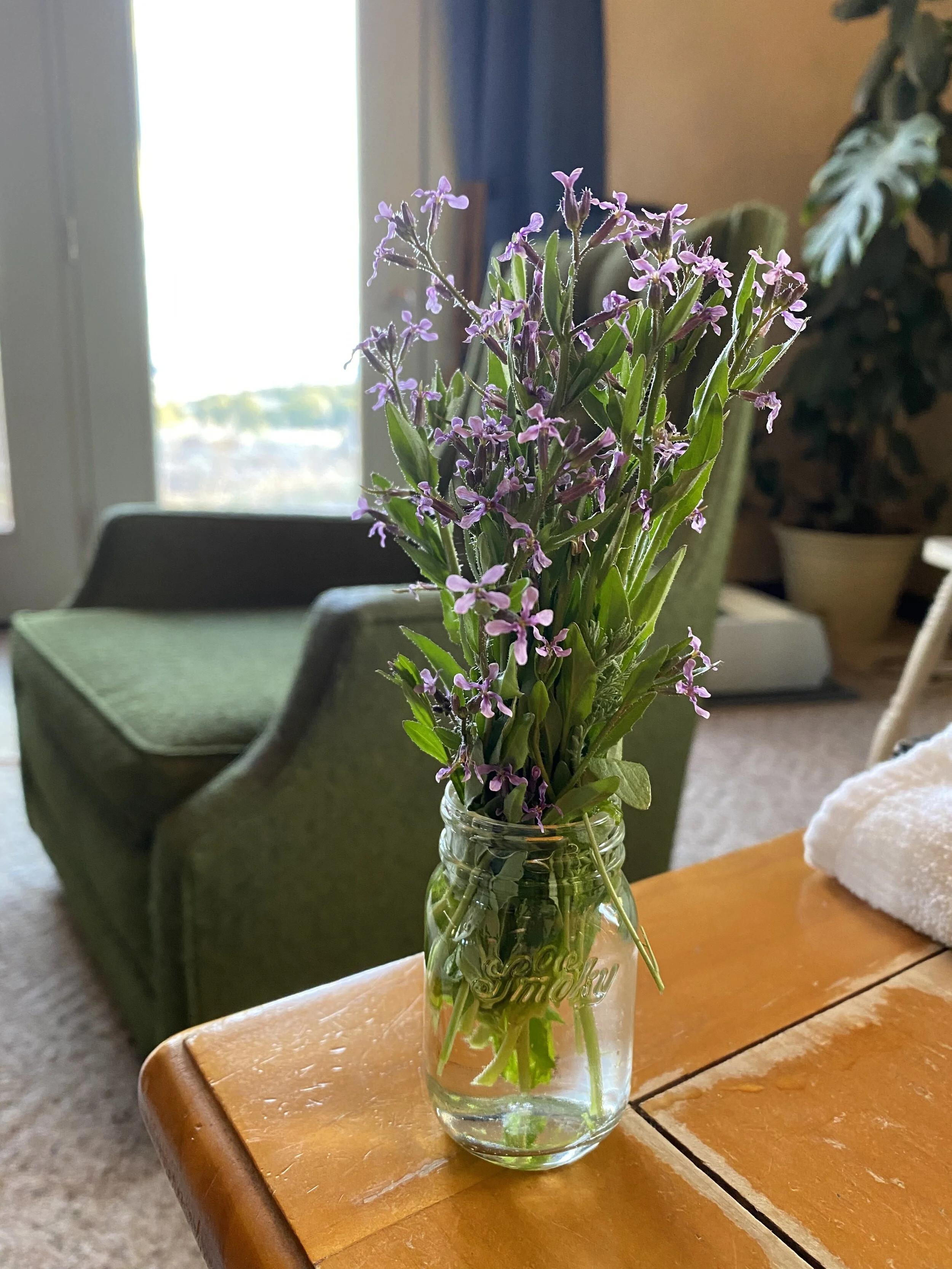Blue Mustard: Tastes like Spicy Radish/Smells Like “Wet Bar Rags”
Image captured by FM Tapia; she just happened to collect the plants to decorate her house the day I wrote this.
A mere ninety-one seasons ago (1929), Chorispora tenella landed in Lewiston, Ohio (USA), via Siberia.
Traveller, it would take me over 18 hours to reach Lewiston if I started driving right now; yet, Blue Mustard is a dominant Spring flower in my area. The following terribly wrought infographic will put this into further perspective for you.
Chorispora tenella is now EVERYWHERE!!!!
There are living people who were born before this plant existed in North America. Today, its baby-blue flowers herald the spring in one massive lilliputian chorus across the entire countryside of the United States. You can’t throw a rock without hitting one.
Sure, the Blue Mustard may not be that “special,” but I’ve got a stinky secret to share… this plant tastes pretty amazing.
Welcome to the odoriferous but tastetacular world of:
BLUE MUSTARD.
Chorispora tenella
Image Captured by Aaron Bieber who just happened to text me this image as I was writing this article. He asked: “what is this plant that smells like wet bar rags?”
Synonyms — Raphanus tenellus, Chorispermum tenellum,
Family — Brassicaceae (Mustard Family)
Family Characteristics — Brassicaceae family members tend to possess 4 petals, 4 sepals, and four stamina. Family members present with 4 tall stamina and two short stamina [1]. The pods occur in a spiraling pattern and often point upward (think: spiral staircase). The flowers develop from bottom-to-top, so usually fruits occur below the flowers.
Aliases — Blue Mustard, Crossflower, Musk Mustard, Purple Field Mustard, Purple Mustard, Tenella Mustard; 离子草 (CHINESE).
Binomial Etymology —Chori- is derived from a Greek word meaning “separate,” and -spora, also derived from Greek, refers to “seeds”[4]. tenella is derived from Latin and means “delicate.”
Binomial Pronunciation: —CHORE-eh-spore-uh ten-EL-uh
Description
Seedlings first appear as rosettes with deeply lobed leaves. Mature leaves are oblanceolate with margins that can be both wavy and coarsely toothed and have minute hairs with glands on their tips. The flowers are 4-petaled in a cross shape and are joined by a pedicel to a central stem also sparsely covered with glandular hairs [5]. Seed pods curve upward to a point.
Culinary Uses
I found an interesting footnote in famed botanist Peter Simon Pallas’s memoir, Travels through the southern provinces of the Russian Empire, in the years 1793 and 1794, where he described the flavor of blue mustard in passing.
[3]
The translation of the above footnote reads: “I wrongly gave this plant the name Cheiranthus chius, in the first volume of these Voyages. On the contrary, it is a radish, the species of which was still unknown. Its leaves have absolutely the same taste as other radishes…[3]”
I couldn’t agree with Pallas more; Blue mustard leaves taste exactly like spicy radishes with the texture of spinach. Now, the smell is quite another thing.
The glandular hairs covering this plant contain an, eh hem, “aromatic” musk that would be more at home inside the anal sack of a swamp rodent.
Hello, little fella! Can I pet you?
*Pbbbttt...
GET IT AWAY FROM ME!!!
I handled quite a few of these plants for the article, and the aroma became quite concentrated on my hands. Dealing with only one or two plants, however, should be fine.
Notwithstanding, the leaves can be readily enjoyed as a spicy addition to salads. I have started an experiment in fermentation: Blue Mustard/Sriracha Kimchi. We shall see if lactobacillus can take care of this odor issue.
[Update]: Fermentation did much to intensify the skunk-like odors. The flavor was good, but for the odor, I cannot recommend the kimchi treatment.
Blue Mustard Recipes
Having no pretensions to ability in the kitchen, I will entrust you, dear reader, to the care of Ellen Zachos from backyardforager.com. Ellen’s intrepid kitchen experimentation has led the world to:
Blue Mustard in Poetry
Behold! The World’s only haiku dedicated to Blue Mustard.
Sing loud, blue mustard
Summer’s incoming kingdoms
Malodorous song
(The Poet Kevin Healey, 2020)
Outro
Usually it is the shortest articles that take the longest to write. This article is not an exception. Blue mustard has been mentioned in thousands of books throughout centuries, however, most of these books are only lists of wayside plants and weeds. Together, perhaps, we can build the story of blue mustard. Please comment with your recipes, stories, and experiences with Chorispora tenella below.





![[3]](https://images.squarespace-cdn.com/content/v1/59bae60f1f318d07a99856a4/1584217743654-NGR8KCB0TW515I7E3AXU/Screen+Shot+2020-03-14+at+2.20.39+PM.jpg)

